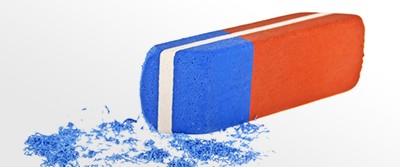Rewritable Paper Inspired by Erasable Ink

By Moira Bell
Writing or drawing takes patience and foresight — but even with the best preparation, you’re bound to make a mistake you wish you could erase. It may even cause you to start over. But what if you didn’t have to start with a new piece of paper? What if you could simply make your original prose or masterpiece disappear? That’s the beauty of a new kind of rewritable paper: unlike older iterations, it can be used more than 100 times and your creation will remain visible for at least six months.
Luzhuo Chen, physicist at Fujian Normal University in Fuzhou, China, and team covered their rewritable paper in the same kind of ink found in erasable pens. Heat makes the ink disappear. A heated pen or printer can erase the blue ink, leaving behind your message or design in white. If you want to erase your creation, you simply rub the paper with the pen’s special eraser. To make it reappear, just put the paper in the freezer.
Vanishing Act
This new method turns traditional writing on its head.Instead of applying ink to paper, the ink is erased from the paper, leaving your writing in its place. This seemingly magical occurrence is made possible by a redox reaction. The process combines reduction (when a molecule gains an electron) with oxidation (when a molecule loses an electron).
In the case of this paper, bisphenol A (or BPA, the color developer) takes an electron from crystal violet lactone (the color-forming agent). The message becomes visible when the color-forming compound and its developer dissolve in a proprietary solvent. Researchers theorize that it’s an aliphatic ester or an aliphatic carboxylic acid.
The solvent melts at 150°F (65°C), causing the lactone and BPA in the ink to dissolve. At this point, the solvent separates the lactone from the BPA so oxidation does not occur. Now the ink that was blue becomes clear, and stays clear at room temperature. Chilling the ink to 14°F (-10°C) causes the lactone and developer to crystallize, which lets the lactone oxidize again. And voilà! The paper is again ready for writing. But be aware that your work will start to fade after six months from the effects of sunlight, cold temperatures or other chemicals.
While the paper is easy to produce and fairly inexpensive, there are potential drawbacks: in addition to requiring a lot of ink, the paper contains BPA, a chemical that may be harmful to health when present in sufficient quantities, according to initial findings by the U.S. Food and Drug Administration (FDA). Perhaps a future version that uses less ink and promises to be hazard free, except for the odd paper cut, will one day have great staying power.
Discussion Questions
- Imagine different ways you can use rewritable paper in your daily life.
- Research chemicals with similar properties to BPA. What qualities make them good replacements?
Vocabulary
- BPA
- Solvent
- Oxidation
- Lactone